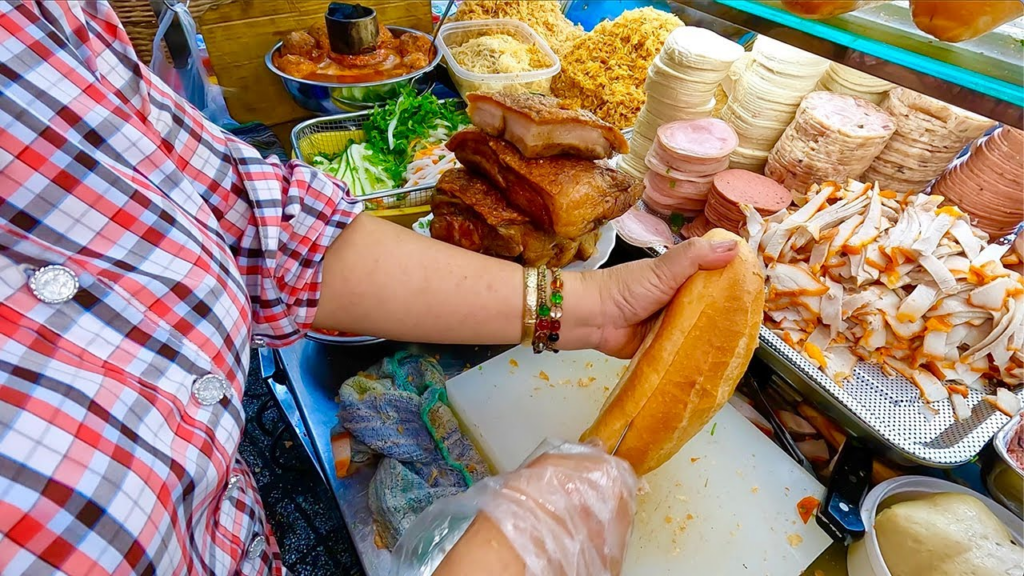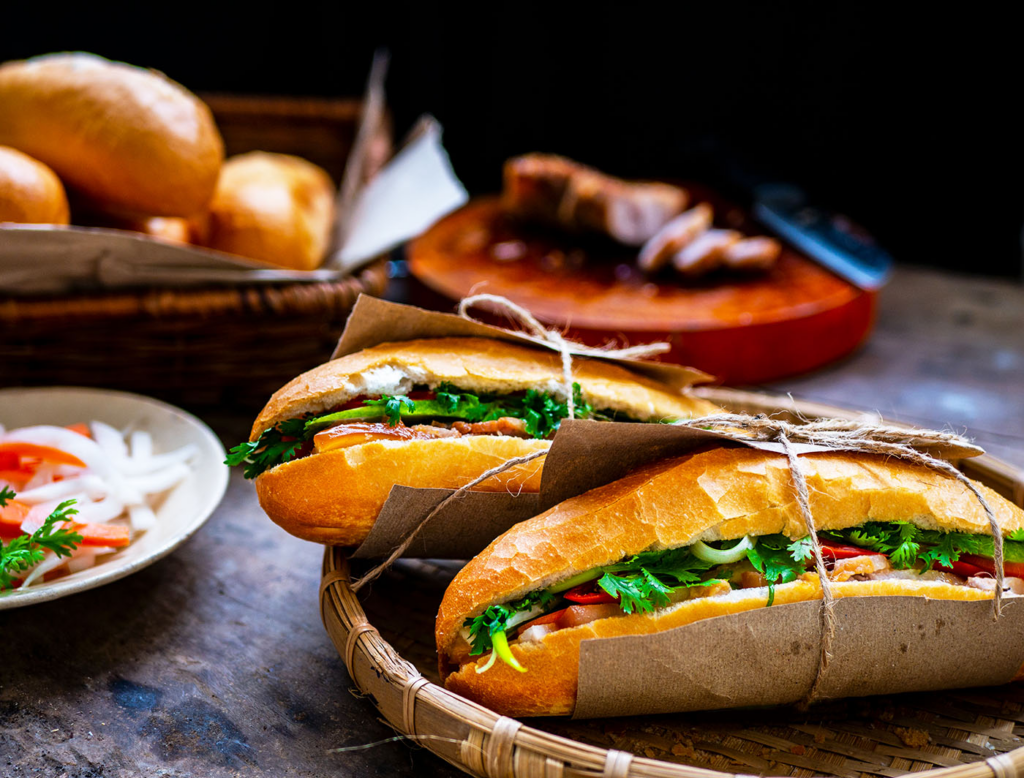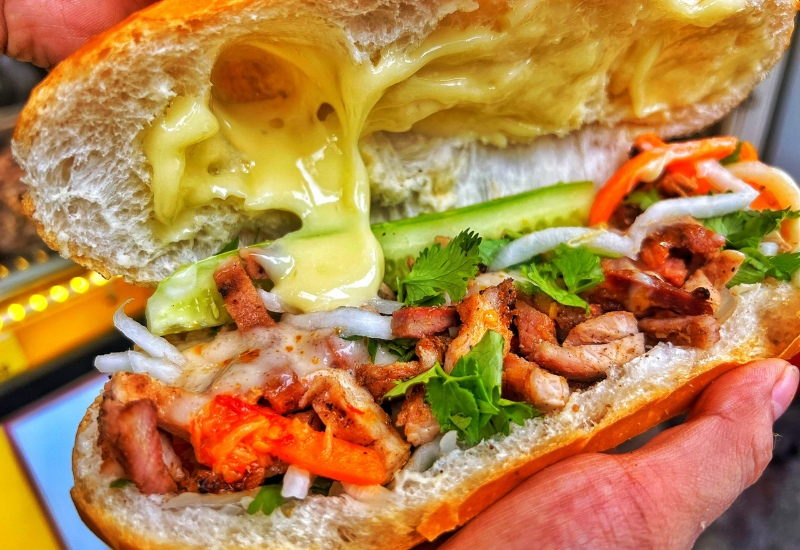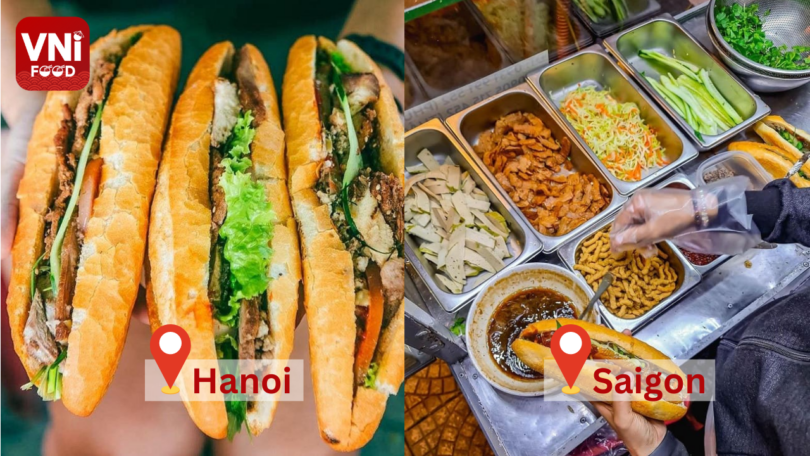Banh Mi of Vietnam

Banh Mi is one of Vietnam’s most beloved culinary exports, a perfect example of the country’s rich cultural fusion. Originating during the French colonial era, this iconic sandwich combines French baguettes with Vietnamese fillings and flavors. However, as you travel across Vietnam, you’ll find that the preparation and ingredients of Banh Mi can vary significantly from region to region. Two of the most famous styles come from Ha Noi in the north and Sai Gon (Ho Chi Minh City) in the south. Let’s explore what makes each version unique.
Banh Mi Ha Noi

Banh Mi Ha Noi, this iconic sandwich beautifully blends French influence with traditional Vietnamese flavors, creating a harmonious and satisfying meal.
– Key Characteristics:
- Bread: The baguette used in Ha Noi is typically denser and shorter than its southern counterpart. It has a crisp crust and a slightly chewy interior, offering a solid foundation for the fillings.
- Filling: Fillings are kept simple and traditional. Common choices include cold cuts like pork liver pâté and ham, complemented by slices of cucumber for freshness.
- Condiments: A light spread of butter or pâté is usually all that’s needed. Sauces are used sparingly, allowing the natural flavors of the meat and pickles to shine.
- Vegetables: The addition of vegetables is more restrained. You might find a modest amount of pickled carrots and daikon, with fewer fresh herbs compared to the southern version.
- Flavor Profile: The overall flavor is subtle and balanced, emphasizing the savory and umami aspects of the ingredients. This restraint is a hallmark of northern Vietnamese cuisine, where less is often more.
– Popular Variations:
- Banh Mi Pâté: A simple yet satisfying option with a generous layer of pâté and fresh cucumber.
- Banh Mi with Cold Cuts: A combination of traditional Vietnamese cold cuts, often with a sprinkle of pork floss for added texture.
Banh Mi Sai Gon

Banh Mi Sai Gon, a vibrant and flavorful delight from the bustling city of Ho Chi Minh, showcases the dynamic and diverse nature of southern Vietnamese cuisine. This version of the iconic Vietnamese sandwich is renowned for its generous fillings and bold flavors, making it a must-try for food enthusiasts.
In Sai Gon, the baguette is lighter and airier, with a thin, crispy crust that perfectly complements the abundant fillings. You’ll find a variety of savory options such as grilled pork, succulent meatballs, and shredded chicken, all enhanced with a medley of fresh herbs, pickled vegetables, and a liberal drizzle of flavorful sauces.
– Key Characteristics:
- Bread: The baguette used in Sai Gon is lighter, airier, and often longer, with a crispier and thinner crust. This allows for a larger, more generous filling.
- Filling: The fillings in Sai Gon are diverse and plentiful. You’ll find options ranging from grilled meats like pork or chicken to meatballs and even seafood. The sandwiches are often packed with a variety of textures and flavors.
- Condiments: A more liberal approach is taken with condiments. Mayonnaise, butter, and a sweet-savory soy sauce or Maggi seasoning are commonly used. For those who like a bit of heat, chili sauce or fresh chili slices are often added.
- Vegetables: There’s no holding back on vegetables. Fresh herbs such as cilantro are plentiful, and a generous amount of pickled carrots and daikon adds a refreshing crunch and tangy flavor.
- Flavor Profile: The flavors in Banh Mi Sai Gon are bold and diverse, often combining sweet, savory, and spicy elements. This creates a robust and dynamic taste experience that’s a delight for the senses.
– Popular Variations:
- Banh Mi Thit Nuong (Grilled Pork Banh Mi): Features succulent grilled pork with pickled vegetables and fresh herbs.
- Banh Mi Xiu Mai (Meat Ball Banh Mi): A hearty option with Vietnamese meatballs in a rich tomato-based sauce.
- Banh Mi Ga (Chicken Banh Mi): Shredded chicken paired with creamy mayonnaise, soy sauce, and a medley of fresh vegetables.
Comparison Summary
Here’s a quick look at how Banh Mi Ha Noi and Banh Mi Sai Gon stack up against each other:
| Aspect | Banh Mi Ha Noi | Banh Mi Sai Gon |
| Bread | Denser, shorter, crisp crust | Lighter, fluffier, longer, crispier |
| Filling | Simple, traditional cold cuts | Varied, generous, includes grilled meats |
| Condiments | Light spread of butter/pâté | Liberal use of mayonnaise, soy sauce, chili |
| Vegetables | Limited, fewer herbs, subtle pickles | Abundant, fresh herbs, tangy pickles |
| Flavor Profile | Subtle, balanced, savory | Bold, diverse, sweet, savory, spicy |
- Ha Noi: The Banh Mi from Ha Noi mirrors the capital’s appreciation for tradition and understated elegance. The ingredients and flavors are kept simple and refined, offering a taste that’s both comforting and familiar.
- Sai Gon: In contrast, Banh Mi Sai Gon is a reflection of the city’s bustling, cosmopolitan nature. The sandwiches are more generous and adventurous, with a vibrant mix of ingredients that cater to the diverse palate of its residents and visitors.
Conclusion
Both Banh Mi Ha Noi and Banh Mi Sai Gon are delicious representations of their respective regions, offering unique culinary experiences. Whether you prefer the subtle, balanced flavors of the north or the bold, diverse tastes of the south, each version of Banh Mi provides a delightful journey into the heart of Vietnamese cuisine. So, next time you’re in Vietnam, be sure to try both and savor the distinct flavors each region has to offer.








